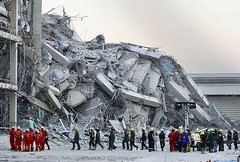Dear Esteemed Dharma Brothers and Sisters of Australia and New Zealand,
With hearts heavy and spirits deeply moved by the catastrophic earthquake that has devastated Myanmar, the Unified Vietnamese Buddhist Congregation of Australia and New Zealand extends our sincerest condolences to the bereaved families and all those suffering unimaginable loss.
In the face of the profound sorrow and devastation afflicting the people of Myanmar, the Unified Vietnamese Buddhist Congregation of Australia and New Zealand convened an emergency meeting at 8:30 PM on April 1, 2025, to urgently appeal to all temples, monasteries, and fellow Buddhists within and beyond our congregation to extend their compassionate hands and provide aid to the suffering people of Myanmar during this time of immense hardship.
Your generous contributions can be made at the following temples within our congregation:
1. Quang Minh Temple, Melbourne
2. Hoa Nghiem Temple, Melbourne
3. Phuoc Hue Temple, Sydney
4. Thien Hoa Nunnery, Sydney
5. Loc Uyen Monastery, Melbourne
6. Bao An Temple, New Zealand
7. Thien Thai Temple, New Zealand
8. … (and other temples within the Congregation)
The death toll from the devastating earthquake that struck Myanmar last week has tragically exceeded 2,500, with heart-wrenching accounts emerging of the final moments of many victims. Two hundred Buddhist monks were crushed beneath a collapsed monastery, and fifty innocent children perished when their kindergarten classroom crumbled.
This catastrophic earthquake threatens to exacerbate the already dire conditions of famine and disease outbreaks in a nation that is already one of the most challenging environments for humanitarian organizations due to ongoing civil conflict, as warned by aid groups and the United Nations.
The powerful 7.7 magnitude earthquake struck on Friday, with its epicenter near Mandalay, Myanmar's second-largest city. It severely damaged the city's airport, warped roads, and caused the collapse of hundreds of buildings across a vast swathe of the country's central region.
This earthquake, triggered by a massive fault line stretching from Myanmar to Thailand, has also impacted Thailand, Laos, China, and even caused mild tremors in Vietnam.
The epicenter was located near Mandalay, a city with a population of approximately 1.5 million, and about 200 kilometers (125 miles) north of the capital city, Nay Pyi Taw.
The initial earthquake struck at approximately 12:50 PM (06:20 GMT), according to the USGS, followed by a second quake 12 minutes later with a magnitude of 6.4, its epicenter located 18 kilometers south of Sagaing.
Relief efforts are being severely hampered by widespread power outages, fuel shortages, and unstable communication networks. The lack of heavy machinery has further slowed search and rescue operations, forcing many to search for survivors by hand in daily temperatures exceeding 40 degrees Celsius (104 degrees Fahrenheit).
The Myanmar military government has confirmed that as of May 3rd, the official death toll from the earthquake has reached 3,000, with an additional 4,300 injured and 410 still missing. Hundreds of Buddhist temples across Myanmar have been destroyed in the earthquake.
The casualty count from the 7.7 magnitude earthquake in Myanmar is expected to continue rising as rescue efforts persist.
Throughout central Myanmar, rescue teams are struggling to extract those trapped beneath collapsed buildings. Homes, temples, churches, schools, hotels, and hospitals have all suffered damage or destruction.
Rescue operations are being hindered by a lack of equipment, with some rescue workers resorting to using their bare hands to search for missing persons amidst the rubble.
Power outages, communication disruptions, and damaged roads and bridges are further compounding the difficulties faced by rescue teams.
Hospitals in Myanmar are overwhelmed with the influx of patients following the earthquake.
At Mandalay General Hospital, which has a capacity of 1,000 beds, hundreds of patients have been moved outdoors for treatment.
In Sagaing, buildings have collapsed virtually everywhere following the earthquake. The provincial fire department headquarters is among the destroyed structures, damaging all of the equipment and rescue vehicles inside.
Sagaing Hospital has also sustained damage, forcing patients to receive treatment outdoors in the scorching heat.
Ma Ei, who is involved in humanitarian aid efforts, witnessed approximately 300 patients arriving at Sagaing Hospital immediately after the earthquake. Most suffered from broken limbs and head injuries.
"There may be even more patients. Some patients with chronic illnesses are suffering even more," Ma Ei added.
Patients in Sagaing requiring more complex treatment are being transferred to Mandalay, Myanmar's second-largest city, which houses the region's largest hospital. However, roads and bridges have been severely damaged, and even if they are repaired, the city's general hospital is already operating at full capacity.
"I am middle-aged and have experienced many incidents, but I have never been this busy. The situation is extremely serious," a doctor at Mandalay General Hospital stated.
The United Nations has warned of "critical shortages of medical supplies," including trauma kits, blood bags, anesthesia, support equipment, essential medications, and tents for medical personnel in Myanmar.
The United States Geological Survey estimates that the death toll from the earthquake in Myanmar could reach as high as 10,000.
We express our deepest gratitude for your boundless compassion and unwavering support. May the blessings of the Triple Gem shower upon you and your families, granting you peace, well-being, and limitless merit.
With profound sincerity,
Dr Phuc Nhan Pham




